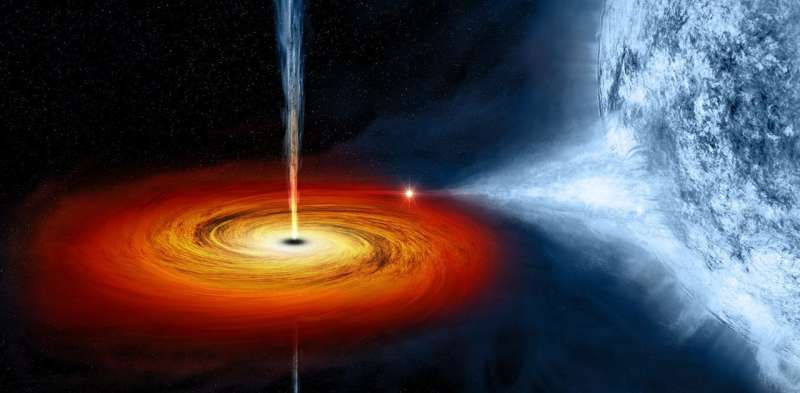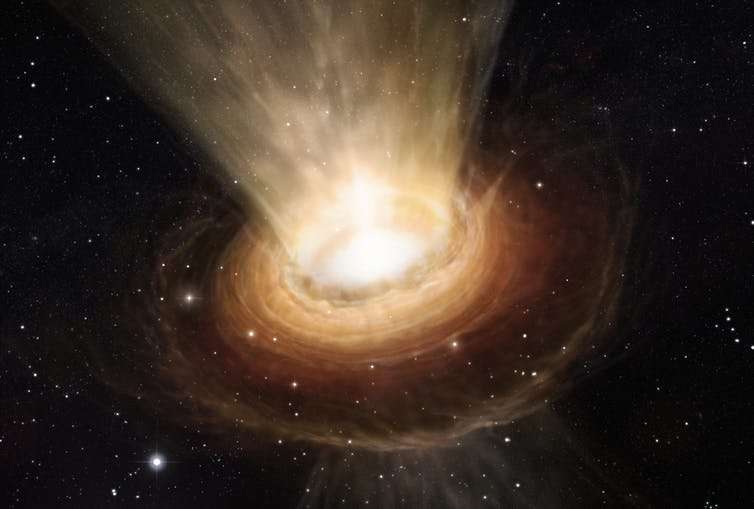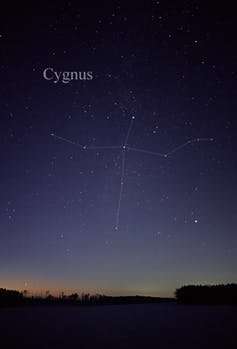Rare glimpse of a black hole's magnetic field could help us to understand how it feeds

Encountering a black hole would be a frightening prospect for our planet. We know that these cosmic monsters ferociously devour any object that strays too close to their "event horizon" – the last chance of escape. But even though black holes drive some of the most energetic phenomena in the universe, the physics of their behaviour, including how they feed, remains hotly debated.
In particular, the conditions close to the black hole and the role of its magnetic fields are thought to be key, but are notoriously difficult to probe in distant cosmic systems. Now an international team of astronomers have for the first time measured the precise magnetic field properties close to a black hole in our own Milky Way galaxy.
The results of study, published in Science, could help us better understand the mysterious process by which black holes swallow matter and grow.
Predicted mathematically from Einstein's theory of general relativity, we now think that black holes come in a range of sizes. Supermassive black holes – with a million to a billion times the mass of our sun and about the size of our solar system in extent – are thought to lie at the heart of all massive galaxies and are likely to play a decisive role in the formation and evolution of galaxies.
At the other extreme, there are black holes just a little more massive than our sun but contained in a region only a few kilometres across. They form in the cataclysmic death throes of massive stars or the merger of dense stellar remnants such as neutron stars or a neutron star colliding with another stellar black hole. When they merge, they produce gravitational waves.

Studies of gamma ray bursts (bursts of light with very high energy) have previously suggested that large-scale magnetic fields could form close to black holes and cause jets of charged gas to escape from them. A similar mechanism is expected for supermassive black hole systems, which launch jets that spread over distances of millions of light years and are visible to networks of radio telescopes such as the Very Large Array. However, even the nearest supermassive black hole is nearly 30,000 light years away from us, so it is technically challenging to probe their magnetic fields.
Cosmic burp
The new study looks at a black hole that lies only 8,000 light years from Earth, part of a "binary system", dubbed V404 Cygni. This consists of a black hole with the mass of ten suns and a star similar to our own sun (but slightly cooler), which orbit each other every 6.5 days. In such systems, material from the star can fall towards the companion black hole to be gradually swallowed by it.
On its journey, the matter heats up, shines brightly and – in the presence of magnetic fields – some of it may be ejected back into space in the form of a focused beam of charged gas (plasma) or jets at bulk speeds close to that of light. Exactly how the magnetic fields cause this effect is still unknown. Luckily, the flares tend to be long-lived and their brightness can be monitored from Earth.

On June 15, 2015, V404 Cygni produced such an outburst – analogous to flares seen from the sun – that lasted for two weeks. The team, which immediately pointed a number of different telescopes at it, then noticed that the brightness of the system decreased suddenly and unexpectedly around June 25 across light frequencies ranging from X-rays to infrared.
They realised that this precipitous drop in brightness signalled that the system was cooling. By comparing this drop in brightness with models that predict how electrons produce light and lose energy – cool – when they spiral around magnetic field lines, the team were able to make a very precise estimate of the strength of the magnetic field. At 461 Gauss (a measurement of magnetism), this is much weaker than expected – only ten times stronger than a typical fridge magnet.
By studying how the properties of the light depended on frequency and time, they showed that the region from which the light was emitted was not expanding, as would be expected if the matter in this region formed part of a jet outflow. Instead, the research shows that there is a hot halo of charged particles held in place by a magnetic field around the black hole. The long-term fate of this halo gas is unknown, but it could be considered one of the last staging posts for fuel to reach the black hole and, if cooled further, may ultimately feed the black hole itself.
This work is important as it lays the foundations for future studies of this intriguing system to discover how black holes feed and how, if overfed, they may "burp" by launching focused beams or jets. Fortunately, V404 Cygni is sufficiently close to be an ideal laboratory for future studies of black hole feeding and cosmic indigestion, but far enough from Earth not to be a threat to us.
More information: Yigit Dallilar et al. A precise measurement of the magnetic field in the corona of the black hole binary V404 Cygni, Science (2017). DOI: 10.1126/science.aan0249
Journal information: Science
Provided by The Conversation
This article was originally published on The Conversation. Read the original article.![]()





















